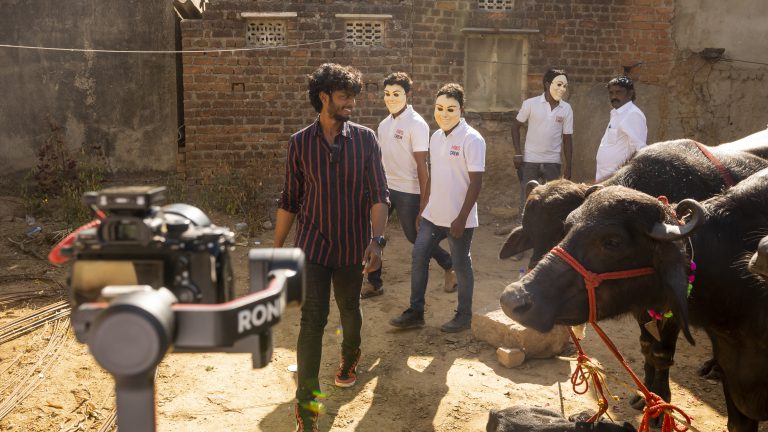At 5:20 a.m. on a Wednesday, two trucks packed with 22 buffaloes and a dozen young calves rolled into Kothapet village in the south Indian state of Telangana. The cattle had traveled over 1,000 miles to make a star appearance in the latest video of Telugu-language social media sensation Harsha Sai.
The 24-year-old YouTuber — also the platform’s top 2022 breakout creator in India — has amassed an online following of over 20 million with his flamboyant acts of charity. For this particular video, titled “I made a poor milkman into a millionaire,” Sai was orchestrating a surprise for a milkman, his wife, and their ailing son. The buffaloes were 100-pound bovines from the Murrah breed, known as “black gold” because of their high-volume milk production. At 6:30 a.m., Sai’s crew unloaded the buffaloes onto the unsuspecting family’s front yard.
The couple, stunned to discover they were now the owners of prized buffaloes, collapsed in tears at Sai’s feet. “The buffaloes could produce 400,000 rupees [around $4,850] worth of milk a month,” Sai told Rest of World during the shoot. “What else [do] they need?” He also gifted the couple a new buffalo shed built on 200,000 square feet of land to house their livestock. The logistics of executing this grand spectacle took nearly three months, and cost Sai over $60,000. The video, uploaded on February 26, now has over 5 million views.

Sai is India’s most popular stunt philanthropist, a YouTube genre where generous acts of kindness are turned into spectacles garnering millions in views and ad revenue. This model, pioneered by American YouTube juggernaut MrBeast, has been localized by creators like Sai, who seek out those in need and bestow them with large sums of cash and expensive gifts. Sai claims he has used the money from his YouTube ad revenue or brand sponsorships, and sometimes from diluting his stock portfolio, to fund opulent charity acts — such as turning a poor barber into a millionaire and buying an SUV using only coins — building a media empire out of pursuing audacious stunts.
“Everyone asks me what genre [of videos are you] making?” Sai said. “I make satisfying videos. It is so satisfying to watch.”
But, as stunt philanthropy gains popularity, Sai’s charity stunts have come under scrutiny, with questions raised around his wealth. His fans hold him up as an example of a selfless man, a devuda or god, instilling the message of altruism in the internet age. Some detractors believe Sai is a fame-hungry braggart exemplifying everything that’s wrong with influencer culture and what happens when philanthropy is reduced to a spectacle, with the poor used as props for views.

“The use of dramatic orchestral music in specific sections, fast-paced editing, the constant pursuit of grand and engaging spectacles, taking on massive logistical challenges, and witnessing the drama of it potentially all falling apart” are all telltale signs of the “kindness for clicks” genre of content, according to Matthew Wade, a lecturer in the department of social inquiry at La Trobe University. Wade, who researches online creators pursuing philanthropy as a spectacle, reviewed Sai’s videos and told Rest of World that the YouTuber places extreme emphasis on rewards and participation in contests reserved only for subscribers — an obvious but effective tactic to boost growth. Sai’s videos “often include a repeated ‘tease’ for what will happen at the end of the video, to maintain viewer engagement and retention,” Wade said.

Sai’s first brush with YouTube popularity came in 2019, while attending engineering school in the south Indian city of Visakhapatnam, after Instagram posts flaunting his six-pack abs received significant attention. He received multiple requests from college friends inquiring about his diet, prompting him to hop on TikTok and YouTube to share health tips. “I started telling my secrets, like it’s about diet and precise training model,” Sai told Rest of World. By the time he graduated in 2020, Sai had amassed 900,000 subscribers on YouTube.
To ensure user retention on his videos, Sai introduced cash giveaways in late 2020. He offered viewers a chance to win up to 2,000 rupees ($24) if they forwarded screenshots of them sharing his videos in WhatsApp groups and used his referral code to sign up for an online stock trading platform. Slowly, the scale of the contests grew larger and the premise became more elaborate — Sai’s videos now included a “quarter million game series,” selling “masks made of money” during the Covid-19 pandemic, “buying a random kid his dream toys (emotional),” and a game on “how fast can you spend” 100,000 rupees (around $1,220).
By 2022, Sai had moved into big-budget, movie-style productions. With 35 million views across channels, one of his most viral videos is the one where he opened a free petrol station for a day for his subscribers. Chaos ensued, with nearly 2,000 people flooding the petrol station. Local police and bouncers stepped in to contain the crowd. In his anglicized Telugu accent, Sai narrates the hurdles he faced while executing his grand plan: finding the right petrol station partner, ballooning expenses, and seeking permissions from local authorities. Today, Sai has dubbed his content in multiple Indian languages including Tamil and Hindi, reaching a cumulative subscriber base of 20 million.
But as Sai’s star rose, suspicions of these displays of generosity intensified. In summer 2022, Jaffar Babu, a Telugu journalist, began investigating Sai’s income, the authenticity of his beneficiaries, and rumors of him harboring political ambitions, on his YouTube news channel Itlu Mee Jaffar. “YouTube is capable of influencing, therefore it is worth investigating,” Babu told Rest of World.

After multiple discussions, Sai offered his first on-camera interview to Babu, where he explained that his income is a mix of YouTube sponsorships and personal investments in stocks. He said he had no political ambitions, that his channel existed to “inspire” people, and that all accusations against him were baseless. Babu questioned Sai on why his team wears face masks in all videos, which Sai said was done to ensure they aren’t doxxed or hounded by fans. The interview, which garnered over 7 million views on YouTube, only aided Sai’s popularity.
“We can’t make everyone happy. [There will always be] few people with doubt,” Sai told Rest of World, adding that the criticism pales in comparison to the support he has received.
Sai has also come under scrutiny for what his critics have called self-aggrandizing and farcical actions. His “I opened free 5 star hotels for poor” video, for example, portrays him as a person motivated by a sense of justice. While such videos may offer some useful social commentary on class divisions, wealth inequality, and poverty, they don’t necessarily help in developing ongoing structural remedies, said Wade, whose research focuses on the intersection of technology and morality.

Prior to the rise of social media, television was the dominant format for stunt philanthropy. “Oprah [Winfrey]’s 2004 ‘You get a car!’ moment proved hugely influential, and was likely the inspiration for much of what was to come with regard to spectacles on giving on social media,” Wade told Rest of World.
“Sai anna is a real hero. Devudu.”
American sensation Jimmy Donaldson aka MrBeast is the modern pioneer of the genre of stunt philanthropy; his videos range from gifting his 100 millionth subscriber an island to “curing” 1,000 blind people. One of the key differences between MrBeast and Sai, Wade noted, is that rather than giving indiscriminately to anyone, Sai focuses on the “deserving” poor — people who have worked hard to provide for themselves and their families and yet, find themselves in difficult financial circumstances.
But the economics of running a MrBeast-style YouTube channel in India are wildly different and more challenging compared to making such content in the West.

Most YouTubers make money through ads showcased in their videos, which widely vary from region to region. The cost per thousand views, or CPM, for an Indian viewer is one-tenth the cost for an American viewer, so the maximum ad revenue Sai makes from his viral videos is minuscule compared to creators in Western countries. Sai said on an average, he earns about 550,000 rupees (around $6,700) for 10 million views, which doesn’t even cover the production costs of his videos — his most recent video cost at least ten times as much. He claims that he makes the majority of his money through sponsorships and brand collaborations on Instagram.
“I gather all the money. Whenever I feel this money is going to be sufficient, I start making videos. No other calculations involved here,” Sai said, adding that he charges handsomely for promotions on Instagram, where he has 3.6 million followers. This results in Sai creating YouTube videos only once in two to three months. In comparison, MrBeast uploads videos every few weeks.
Despite the criticism of Sai’s methods, there is no denying his celebrity.

After receiving word of Sai’s arrival in Kothapet, a group of youngsters from the neighboring Ratnapur village came to the milkman shoot. “Sai anna is a real hero. Devudu,” Boggula Kumar, one of the young men in the group, told Rest of World. Sai’s giveaways are now a phenomenon in Telangana, where scamsters are leveraging his brand for grift. Rest of World found two Instagram posts advertising “Harsha Sai Home Care,” which Sai confirmed he was not involved in.
“The goal is to make an impact,” he said. “All I want to do is 100 solid videos that inspire people.” To continue outperforming himself, Sai wants to enter the film industry — he is working on his first feature film with a budget of 30 crore rupees ($3.6 million), and hopes to reinvest the gains back into YouTube.





